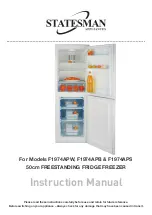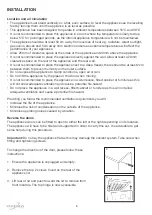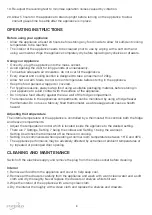
9
5. Plug in and switch on and allow the temperature in the appliance to drop back to an
adequate temperature.
6. Replace the food in the appliance.
Important: Avoid getting water into the electric components of the appliance (i.e. the thermostat) as
this may damage your appliance.
Defrosting the fridge
• Defrosting occurs automatically in fridge compartment during operation; the defrosted water will
be collected by the evaporating tray and evaporates automatically.
• The drain hole in the rear of the fridge compartment should be kept clear from food and debris
to prevent water building up which could result in excess ice formation.
Defrosting the freezer
After a period of time frost will build up in the compartments. Regular defrosting will therefore be
necessary to maintain the efficiency of the appliance. The best time to defrost your appliance is
when the amount of food stored is low.
To defrost the appliance, please follow the steps below:
1. Take out the frozen food and store in a spare freezer, appliance or wrap well and store in a
cool dry place.
2. Unplug the appliance from the mains supply, making sure not to pull the cord.
3. Leave the door open, to speed up the defrosting process, bowls of warm water can be placed
inside the appliance to raise the temperature.
4. Place a shallow bowl or pan below the freezer compartment to catch dripping water.
5. Remove the ice with a plastic ice scrapper. DO NOT use pointed or sharp edged objects such
as knives, forks or screw drivers to remove the ice.
6. When all traces of ice have been removed and defrosting is completed, clean away any water
and wipe your appliance dry.
7. Clean your appliance as described below, plug in and switch back on, Setting 4 on
your temperature control.
8. Allow at least 5 hours for the temperature to return to the adequate temperature before putting
the food back into the appliance.
Important: Do not use any mechanical devices or other means to accelerate the defrosting process
other than those recommended by the manufacturer.
Exterior
• Use a clean, damp soft cloth to wipe the exterior surface of the appliance and dry thoroughly.
• Use a vacuum cleaner to remove dust from underneath the appliance and from around the
compressor which is situated at the back of the appliance, regularly to maintain adequate
ventilation. Use caution not to damage the coolant system.
Important: Do not use abrasive cloths, powders, household cleaners, bleach or wax polish to clean
the appliance as these can leave a smell in the appliance and can damage the exterior.
Door Seal
Use a clean, damp soft cloth to wipe the door seal and in between the creases, avoid damaging the
door seal as this will affect the performance of your appliance.






























